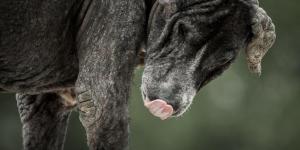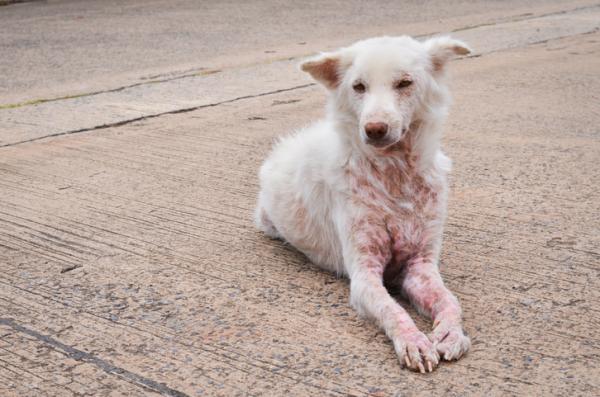Malassezia In Dogs - Contagion, Symptoms, Causes and Treatment



See files for Dogs
Malassezia is a genus of fungi, a yeast that is usually found in human and animal skin surfaces. Malassezia pachydermatitis is the most common type of malassezia found on both dogs and cats. Normally, these yeasts do not cause any harm. However, malassezia infections can occur when the number of malassezia increases. Malassezia infections are opportunistic, which means that they occur due to the appearance of another pathology.
Finding the primary cause of canine malassezia is key in finding out the most appropriate treatment. For more about malassezia dermatitis in dogs and malassezia otitis in dogs, keep reading here at AnimalWised! In addition, we’ll be discussing whether or not malassezia in dogs is contagious, as well as its causes, symptoms and treatment. Find out everything you need to know about Malassezia in dogs here.
Malassezia in dogs: causes
A we’ve already mentioned, malassezia in dogs is genus of fungi, part of normal skin flora. This fungi is beneficial because it inhibits the presence of other organisms that would, if not for the malassezia, be more pathogenic. Skin imbalances that can increase humidity, heat, sebum or immunity can cause malassezia to proliferate, worsening and/or complicating the case at hand. These such malassezia causes include:
- Allergies.
- Dermatitis.
- Otitis.
- Hormonal disease, like hypothyroidism.
- Parasites.
- Prolonged use of corticosteroids or antibiotics.
Canine malassezia symptoms include:
- Folliculitis.
- Inflammation.
- Itching.
- Crusty scale-y skin.
- Skin thickening.
- Hyperpigmentation.
- Seborrhea (dog dandruff), with an increase in the production of sebum, which gives the dog a characteristic musty rancid smell.
For more, we recommend reading our article about home remedies for seborrhea in dogs.
Malassezia dermatitis in dogs
Dermatitis in dogs is a cutaneous inflammation that can be caused by different factors. Dermatitis in dogs caused by malassezia pachydermatis is more frequent in adults dogs. This is often secondary to another pathology.
Malassezia dermatitis in dogs symptoms include:
- Pruritus (itching).
- Absence of hair.
- Erythema (redness).
- Desquamation(skin peeling).
- Thickening of the skim.
- Darkened skin areas.
- Scabs.
- Seborrhea, with its characteristic rancid smell.
Malassezia dermatitis in dogs is more common in breeds such as, Westies, Poodles, Pekingese, Cocker Spaniels, German shepherds and/or Shar peis. In addition, Malassezia dermatitis thrives in the warmer months when there are more parasites, allergens or environmental humidity.
Malassezia dermatitis: additional symptoms
Pododermatitis (paw inflammmation) can also occur due to malassezia. Canine pododermatitis is characterized by an apparent erythema between the fingers and, if the nails become infected, you may also notice a visible brown discoloration.
Atopic dermatitis caused by hypersensitivity to different allergens, such as pollen or dust, can also be linked to canine malassezia. For more, we recommend reading our article about atopic dermatitis in dogs.
Malassezia dermatitis: treatment
When it comes to malassezia dermatitis treatment, degreasing and antifungal shampoos should be prescribed. If the affected area is small, treatment may be limited to a simple application of ointment. If you notice any of the above symptoms on your dog’s skin, we recommend going to the veterinarian as soon as possible for a correct diagnosis, which can only be done with the use of a microscope.

Malassezia in dogs: otitis
Malassezia in dogs can also affect the inside of a dog’s ears. Otitis in dogs refers to an inflammation of the ear canal. When this inflammation is accompanied by an infection, it becomes a favorable habitat for the proliferation of yeast i.e malassezia.
Malassezia otitis symptoms include:
- Ear secretion.
- Red-brown peeling.
- Itching.
- Head shaking.
- Ear rubbing against legs and objects.
Malassezia otitis in dogs usually affects both ears. If you notice any of these above symptoms we recommend visiting a veterinarian as soon as possible in order to prescribe the most appropriate treatment. In this case, you should never apply treatment of your own without consulting a professional, as it may worsen the infection.
Malassezia otitis in dogs: treatment
In the case of malassezia otitis in dogs, medications to fight against the fungus malassezia should be prescribed. This such treatment should also include anti-inflammatories and antibiotics. Treatment should be administered after cleaning the ear canal, as recommended by a veterinarian. However, in order to treat this infection correctly, the primary malassezia cause needs to be identified and treated accordingly.

Is malassezia in dogs contagious?
Malassezia in dogs, in general, is not contagious. There are several species of malessezia and, in principle, the one found in dogs cannot infect humans.
This possible zoonosis is, however, currently under review. This is because it there have been a couple of cases of malassezia pachydermatis infecting people of vulnerability, such as premature infants or immunosuppressed adults[1].
Malassezia in dogs: home remedies
As we’ve already mentioned, a veterinarian should be the ONLY person who can prescribe products specifically formulated to treat malassezia in dogs.
As maintenance however, apart from this treatment, one must always focus on providing their dog with a balanced diet in order to improve general skin health. This diet should be adapted in the case of dogs suffering from allergies. Keep in mind that when bathing your dog, you must make sure to use products made specifically for dogs. In addition, do not over bathe your dog.
For more about dog skin health and malassezia in dogs, we recommend reading our following articles:
This article is purely informative. AnimalWised does not have the authority to prescribe any veterinary treatment or create a diagnosis. We invite you to take your pet to the veterinarian if they are suffering from any condition or pain.
If you want to read similar articles to Malassezia In Dogs - Contagion, Symptoms, Causes and Treatment, we recommend you visit our Skin problems category.







